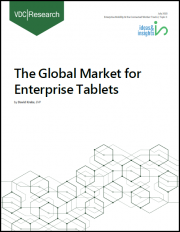
|
시장보고서
상품코드
1635956
울트라 모바일 디바이스(UMD) 시장 : 유형별, 디바이스 유형별, 용도별, 지역별(2025-2033년)Ultra-Mobile Device Market by Type, Device Type, Application, and Region 2025-2033 |
||||||
울트라 모바일 디바이스(UMD) 시장 세계 시장 규모는 2024년 2,237억 달러에 달했습니다. 향후 IMARC Group은 이 시장이 2033년까지 3,411억 달러에 달해 2025년부터 2033년까지 4.56% 연평균 성장률(CAGR)을 기록할 것으로 예측했습니다. 이 시장은 휴대용 컴퓨터 장치에 대한 수요 증가, 작고 가벼운 가젯에 대한 고객 선호도 증가, 배터리 기술의 비약적인 발전, 원격 근무 습관의 개척, 인터넷 접속 증가에 의해 주도되고 있습니다.
울트라 모바일 디바이스(UMD)는 태블릿과 노트북을 포함한 경량 및 중형 컴퓨팅 도구로, 많은 산업 분야에서 다양한 애플리케이션을 지원합니다. 생산성 향상, 배터리 수명 개선, 본격적인 기능, 휴대성 향상, 부피 감소를 촉진합니다. 기존 키보드 및 마우스와의 연결성을 제공하기 위한 포트가 내장되어 있습니다. 일반적으로 프리미엄, 베이직, 유틸리티로 분류됩니다. 이 중 프리미엄 UMD는 미디어 소비를 위해 사용자 인터페이스를 최적화하고 본격적인 데이터 처리 능력을 보유하고 있습니다. 베이직 UMD는 컨텐츠 소비, 소셜 인터랙션, 데이터 처리 입력을 위해 운영체제(OS)에 연결된 특정 소프트웨어의 사용에 의존하고 있습니다. 이 외에도 유틸리티 UMD의 변형은 프로세서 속도, 화면 크기, 해상도, 카메라 기능을 타협하여 최저 비용을 실현하고 있습니다.
현재 개인의 소득 수준이 향상되고 인터넷 보급률이 높아지면서 UMD와 같은 가전제품에 대한 수요가 크게 증가하고 있습니다. 이는 세계 시장의 성장을 뒷받침하는 중요한 요인 중 하나입니다. 또한, 일상적인 비즈니스 업무를 처리하기 쉽기 때문에 조직에서 UMD의 채택이 증가하고 있습니다. 이 외에도 직장에서의 BYOD(Bring Your Own Device)의 새로운 트렌드와 하이브리드 작업 및 원격 작업 모델의 채택이 증가함에 따라 시장 성장에 기여하고 있습니다. 또한, 인터랙티브 온라인 강의 및 학습 교재로 학생들을 지원하는 UMD의 사용이 증가하고 있는 것도 시장 성장에 긍정적인 영향을 미치고 있습니다. 또한, 이러닝 솔루션의 이점에 대한 인식이 높아지면서 시장 성장을 촉진하고 있습니다. 이와는 별도로 UMD에 최신 터치스크린 인터페이스, 강력한 운영체제, 강력한 프로세서 및 액세서리를 통합한 것이 시장 성장을 강화하고 있습니다. 또한, 혁신적인 기능과 맞춤형 디자인을 갖춘 UMD의 새로운 모델과 고급 모델이 온라인 소매 채널을 통해 할인된 가격으로 제공되고 다양한 결제 옵션을 통해 제공되는 것도 시장 전망을 밝게 하고 있습니다. 또한, 헬스케어, 통신, 소매 분야에서 모니터링 및 보안 목적으로 UMD를 사용하는 사례가 증가하고 있습니다.
본 보고서에서 다루는 주요 질문
- 울트라 모바일 디바이스(UMD) 시장 세계 시장 규모는?
- 2025-2033년 세계 울트라 모바일 디바이스(UMD) 시장의 예상 성장률은?
- 세계 울트라 모바일 디바이스(UMD) 시장을 이끄는 주요 요인은 무엇일까?
- COVID-19가 세계 울트라 모바일 디바이스(UMD) 시장에 미치는 영향은?
- 세계 울트라 모바일디바이스(UMD) 시장 유형별 분류는?
- 세계 울트라 모바일디바이스(UMD) 시장의 디바이스 유형별 구성비는?
- 세계 울트라 모바일디바이스(UMD) 시장의 용도별 시장 현황은?
- 전 세계 울트라 모바일 디바이스(UMD) 시장의 주요 지역은?
- 울트라 모바일 디바이스(UMD) 시장의 세계 주요 플레이어/기업은?
목차
제1장 서문
제2장 조사 범위와 조사 방법
- 조사 목적
- 이해관계자
- 데이터 소스
- 1차 정보
- 2차 정보
- 시장 추정
- 상향식 접근
- 하향식 접근
- 조사 방법
제3장 주요 요약
제4장 소개
- 개요
- 주요 업계 동향
제5장 세계의 울트라 모바일 디바이스(UMD) 시장
- 시장 개요
- 시장 실적
- COVID-19의 영향
- 시장 예측
제6장 시장 내역 : 유형별
- 프리미엄 울트라 모바일 디바이스(UMD)
- 시장 동향
- 시장 예측
- 베이직 울트라 모바일 디바이스(UMD)
- 시장 동향
- 시장 예측
- 유틸리티 울트라 모바일 디바이스(UMD)
- 시장 동향
- 시장 예측
제7장 시장 내역 : 디바이스 유형별
- 태블릿
- 시장 동향
- 시장 예측
- 랩톱
- 시장 동향
- 시장 예측
- 컨버터블
- 시장 동향
- 시장 예측
- 디테처블
- 시장 동향
- 시장 예측
제8장 시장 내역 : 용도별
- 헬스케어
- 시장 동향
- 시장 예측
- 가전제품
- 시장 동향
- 시장 예측
- IT 및 통신
- 시장 동향
- 시장 예측
- 소매
- 시장 동향
- 시장 예측
- BFSI
- 시장 동향
- 시장 예측
- 교육
- 시장 동향
- 시장 예측
- 엔터테인먼트
- 시장 동향
- 시장 예측
- 기타
- 시장 동향
- 시장 예측
제9장 시장 내역 : 지역별
- 북미
- 미국
- 캐나다
- 아시아태평양
- 중국
- 일본
- 인도
- 한국
- 호주
- 인도네시아
- 기타
- 유럽
- 독일
- 프랑스
- 영국
- 이탈리아
- 스페인
- 러시아
- 기타
- 라틴아메리카
- 브라질
- 멕시코
- 기타
- 중동 및 아프리카
제10장 촉진요인, 억제요인, 기회
- 개요
- 성장 촉진요인
- 성장 억제요인
- 기회
제11장 밸류체인 분석
제12장 Porter's Five Forces 분석
- 개요
- 구매자의 교섭력
- 공급 기업의 교섭력
- 경쟁 정도
- 신규 참여업체의 위협
- 대체품의 위협
제13장 가격 분석
제14장 경쟁 구도
- 시장 구조
- 주요 기업
- 주요 기업 개요
- Apple Inc.
- ASUSTeK Computer Inc.
- Dell Inc.
- Google LLC(Alphabet Inc.)
- HP Development Company L.P.
- Lenovo Group Limited
- Microsoft Corporation
- Samsung Electronics Co. Ltd.
The global ultra-mobile device market size reached USD 223.7 Billion in 2024. Looking forward, IMARC Group expects the market to reach USD 341.1 Billion by 2033, exhibiting a growth rate (CAGR) of 4.56% during 2025-2033. The market is propelled by increasing demand for portable computer devices, rising customer preference for tiny and lightweight gadgets, breakthroughs in battery technology, developing remote work habits, and increased internet access.
Ultra-mobile device (UMD) is a lightweight and mid-size computing tool, including tablets and laptops, which supports various applications in numerous industry verticals. It facilitates higher productivity, improved battery life, full-scale functionality, extended portability, and reduced bulk. It is incorporated with ports to provide connectivity with conventional keyboards and mice. It is commonly classified into premium, basic, and utility variants. Amongst these, the premium UMD variant is user-interface-optimized for media consumption and retains capabilities for full-scale data processing. The basic UMD variant depends on the use of specific software linked to the operating system (OS) for content consumption, social interaction, and data processing input. Besides this, the utility UMD variant offers the lowest cost by compromising on processor speed, screen size, resolution, and camera capabilities.
At present, there is a considerable increase in the demand for consumer electronics, such as UMDs, on account of the improving income levels of individuals and the rising penetration of the internet. This represents one of the key factors supporting the growth of the market around the world. Moreover, there is a rise in the adoption of UMDs in organizations, as they are easy to handle day-to-day business tasks. This, coupled with the emerging trend of bring your own device (BYOD) in the workplace and the increasing adoption of the hybrid and remote working models, is contributing to the market growth. In addition, the rising usage of UMDs among students to facilitate them with interactive online lectures and study material is favoring the market growth. The growing awareness about the benefits of e-learning solutions is also currently fueling the market growth. Apart from this, the integration of the latest touchscreen interfaces, robust operating systems, powerful processors, and accessories in UMDs is strengthening the growth of the market. Furthermore, the easy availability of new and advanced models of UMDs with innovative features and customized designs through online retail channels at discounted deals and with innumerable payment options is creating a positive outlook for the market. Additionally, there is an increase in the use of UMDs for monitoring and security purposes in the healthcare, telecommunication, and retail sectors.
Key Market Segmentation:
Type Insights
Premium Ultra-Mobile Devices
Basic Ultra-Mobile Devices
Utility Ultra-Mobile Devices
The report has also provided a detailed breakup and analysis of the ultra-mobile device market based on the type. This includes premium, basic, and utility. According to the report, premium ultra-mobile devices represented the largest segment.
Device Type Insights
Tablet
Laptop
Convertibles
Detachable
Application Insights
Healthcare
Consumer Electronics
IT And Telecom
Retail
BFSI
Education
Entertainment
Others
Regional Insights
North America
United States
Canada
Asia-Pacific
China
Japan
India
South Korea
Australia
Indonesia
Others
Europe
Germany
France
United Kingdom
Italy
Spain
Russia
Others
Latin America
Brazil
Mexico
Others
Middle East and Africa
The report has also provided a comprehensive analysis of all the major regional markets that include North America (the United States and Canada), Asia Pacific (China, Japan, India, South Korea, Australia, Indonesia, and others), Europe (Germany, France, United Kingdom, Italy, Spain, Russia, and others), Latin America (Brazil, Mexico, and others), and the Middle East and Africa. According to the report, North America was the largest market for ultra-mobile device. Some of the factors driving the North America ultra-mobile device market included the increasing reliance on consumer electronics, rising number of people watching OTT content and the growing awareness about the benefits of using UMDs, such as portability and convenience.
Competitive Landscape
The report has also provided a comprehensive analysis of the competitive landscape in the global ultra-mobile device market. Detailed profiles of all major companies have also been provided. Some of the companies covered include Apple Inc., ASUSTeK Computer Inc., Dell Inc., Google LLC (Alphabet Inc.), HP Development Company L.P., Lenovo Group Limited, Microsoft Corporation, Samsung Electronics Co. Ltd. etc. Kindly, note that this only represents a partial list of companies, and the complete list has been provided in the report.
Key Questions Answered in This Report
- 1. How big is the global ultra-mobile device market?
- 2. What is the expected growth rate of the global ultra-mobile device market during 2025-2033?
- 3. What are the key factors driving the global ultra-mobile device market?
- 4. What has been the impact of COVID-19 on the global ultra-mobile device market?
- 5. What is the breakup of the global ultra-mobile device market based on the type?
- 6. What is the breakup of the global ultra-mobile device market based on the device type?
- 7. What is the breakup of the global ultra-mobile device market based on the application?
- 8. What are the key regions in the global ultra-mobile device market?
- 9. Who are the key players/companies in the global ultra-mobile device market?
Table of Contents
1 Preface
2 Scope and Methodology
- 2.1 Objectives of the Study
- 2.2 Stakeholders
- 2.3 Data Sources
- 2.3.1 Primary Sources
- 2.3.2 Secondary Sources
- 2.4 Market Estimation
- 2.4.1 Bottom-Up Approach
- 2.4.2 Top-Down Approach
- 2.5 Forecasting Methodology
3 Executive Summary
4 Introduction
- 4.1 Overview
- 4.2 Key Industry Trends
5 Global Ultra-Mobile Device Market
- 5.1 Market Overview
- 5.2 Market Performance
- 5.3 Impact of COVID-19
- 5.4 Market Forecast
6 Market Breakup by Type
- 6.1 Premium Ultra-Mobile Devices
- 6.1.1 Market Trends
- 6.1.2 Market Forecast
- 6.2 Basic Ultra-Mobile Devices
- 6.2.1 Market Trends
- 6.2.2 Market Forecast
- 6.3 Utility Ultra-Mobile Devices
- 6.3.1 Market Trends
- 6.3.2 Market Forecast
7 Market Breakup by Device Type
- 7.1 Tablet
- 7.1.1 Market Trends
- 7.1.2 Market Forecast
- 7.2 Laptop
- 7.2.1 Market Trends
- 7.2.2 Market Forecast
- 7.3 Convertibles
- 7.3.1 Market Trends
- 7.3.2 Market Forecast
- 7.4 Detachable
- 7.4.1 Market Trends
- 7.4.2 Market Forecast
8 Market Breakup by Application
- 8.1 Healthcare
- 8.1.1 Market Trends
- 8.1.2 Market Forecast
- 8.2 Consumer Electronics
- 8.2.1 Market Trends
- 8.2.2 Market Forecast
- 8.3 IT and Telecom
- 8.3.1 Market Trends
- 8.3.2 Market Forecast
- 8.4 Retail
- 8.4.1 Market Trends
- 8.4.2 Market Forecast
- 8.5 BFSI
- 8.5.1 Market Trends
- 8.5.2 Market Forecast
- 8.6 Education
- 8.6.1 Market Trends
- 8.6.2 Market Forecast
- 8.7 Entertainment
- 8.7.1 Market Trends
- 8.7.2 Market Forecast
- 8.8 Others
- 8.8.1 Market Trends
- 8.8.2 Market Forecast
9 Market Breakup by Region
- 9.1 North America
- 9.1.1 United States
- 9.1.1.1 Market Trends
- 9.1.1.2 Market Forecast
- 9.1.2 Canada
- 9.1.2.1 Market Trends
- 9.1.2.2 Market Forecast
- 9.1.1 United States
- 9.2 Asia-Pacific
- 9.2.1 China
- 9.2.1.1 Market Trends
- 9.2.1.2 Market Forecast
- 9.2.2 Japan
- 9.2.2.1 Market Trends
- 9.2.2.2 Market Forecast
- 9.2.3 India
- 9.2.3.1 Market Trends
- 9.2.3.2 Market Forecast
- 9.2.4 South Korea
- 9.2.4.1 Market Trends
- 9.2.4.2 Market Forecast
- 9.2.5 Australia
- 9.2.5.1 Market Trends
- 9.2.5.2 Market Forecast
- 9.2.6 Indonesia
- 9.2.6.1 Market Trends
- 9.2.6.2 Market Forecast
- 9.2.7 Others
- 9.2.7.1 Market Trends
- 9.2.7.2 Market Forecast
- 9.2.1 China
- 9.3 Europe
- 9.3.1 Germany
- 9.3.1.1 Market Trends
- 9.3.1.2 Market Forecast
- 9.3.2 France
- 9.3.2.1 Market Trends
- 9.3.2.2 Market Forecast
- 9.3.3 United Kingdom
- 9.3.3.1 Market Trends
- 9.3.3.2 Market Forecast
- 9.3.4 Italy
- 9.3.4.1 Market Trends
- 9.3.4.2 Market Forecast
- 9.3.5 Spain
- 9.3.5.1 Market Trends
- 9.3.5.2 Market Forecast
- 9.3.6 Russia
- 9.3.6.1 Market Trends
- 9.3.6.2 Market Forecast
- 9.3.7 Others
- 9.3.7.1 Market Trends
- 9.3.7.2 Market Forecast
- 9.3.1 Germany
- 9.4 Latin America
- 9.4.1 Brazil
- 9.4.1.1 Market Trends
- 9.4.1.2 Market Forecast
- 9.4.2 Mexico
- 9.4.2.1 Market Trends
- 9.4.2.2 Market Forecast
- 9.4.3 Others
- 9.4.3.1 Market Trends
- 9.4.3.2 Market Forecast
- 9.4.1 Brazil
- 9.5 Middle East and Africa
- 9.5.1 Market Trends
- 9.5.2 Market Breakup by Country
- 9.5.3 Market Forecast
10 Drivers, Restraints, and Opportunities
- 10.1 Overview
- 10.2 Drivers
- 10.3 Restraints
- 10.4 Opportunities
11 Value Chain Analysis
12 Porters Five Forces Analysis
- 12.1 Overview
- 12.2 Bargaining Power of Buyers
- 12.3 Bargaining Power of Suppliers
- 12.4 Degree of Competition
- 12.5 Threat of New Entrants
- 12.6 Threat of Substitutes
13 Price Analysis
14 Competitive Landscape
- 14.1 Market Structure
- 14.2 Key Players
- 14.3 Profiles of Key Players
- 14.3.1 Apple Inc.
- 14.3.1.1 Company Overview
- 14.3.1.2 Product Portfolio
- 14.3.1.3 Financials
- 14.3.1.4 SWOT Analysis
- 14.3.2 ASUSTeK Computer Inc.
- 14.3.2.1 Company Overview
- 14.3.2.2 Product Portfolio
- 14.3.2.3 Financials
- 14.3.2.4 SWOT Analysis
- 14.3.3 Dell Inc.
- 14.3.3.1 Company Overview
- 14.3.3.2 Product Portfolio
- 14.3.3.3 Financials
- 14.3.3.4 SWOT Analysis
- 14.3.4 Google LLC (Alphabet Inc.)
- 14.3.4.1 Company Overview
- 14.3.4.2 Product Portfolio
- 14.3.4.3 SWOT Analysis
- 14.3.5 HP Development Company L.P.
- 14.3.5.1 Company Overview
- 14.3.5.2 Product Portfolio
- 14.3.5.3 Financials
- 14.3.5.4 SWOT Analysis
- 14.3.6 Lenovo Group Limited
- 14.3.6.1 Company Overview
- 14.3.6.2 Product Portfolio
- 14.3.7 Microsoft Corporation
- 14.3.7.1 Company Overview
- 14.3.7.2 Product Portfolio
- 14.3.7.3 Financials
- 14.3.7.4 SWOT Analysis
- 14.3.8 Samsung Electronics Co. Ltd.
- 14.3.8.1 Company Overview
- 14.3.8.2 Product Portfolio
- 14.3.8.3 Financials
- 14.3.8.4 SWOT Analysis
- 14.3.1 Apple Inc.
Kindly, note that this only represents a partial list of companies, and the complete list has been provided in the report



















